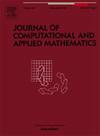基于 B-样条的高阶数值方案,用于求解时间分数福克-普朗克方程
IF 2.1
2区 数学
Q1 MATHEMATICS, APPLIED
Journal of Computational and Applied Mathematics
Pub Date : 2024-11-21
DOI:10.1016/j.cam.2024.116386
引用次数: 0
摘要
Jiang(2014)、Vong 和 Wang(2014)以及 Roul 等人(2022)提出了求解时间分数福克-普朗克(TFFP)方程的低阶计算技术。本文涉及 TFFP 方程的两种高阶计算方案的设计。第一种方案是基于 L2-1σ 方案和标准五次 B 样条配位法的组合,而第二种方案是基于 L2-1σ 方案和一种新技术(即改进的五次 B 样条配位法)的组合。分析了所建议方法的收敛性。举例说明了建议方法的适用性和效率。第一种和第二种方法的收敛阶数分别为 O(Δt2+Δx4)、O(Δt2+Δx6),其中 Δt 和 Δx 分别为时域和空域的步长。我们将计算结果与有限差分法 (FDM)、紧凑 FDM 和四元 B 样条拼合法的结果进行了比较,以证明所提方案的优势。本文章由计算机程序翻译,如有差异,请以英文原文为准。
High-order numerical schemes based on B-spline for solving a time-fractional Fokker–Planck equation
The authors of Jiang (2014), Vong and Wang (2014) and Roul et al. (2022) proposed lower-orders computational techniques for solving a time-fractional Fokker–Planck (TFFP) equation. This paper deals with the design of two high-order computational schemes for the TFFP equation. The first scheme is based on a combination of scheme and standard quintic B-spline collocation method, while the second one is based on a combination of scheme and a new technique, namely improvised quintic B-spline collocation method. Convergence of the suggested method is analyzed. An illustrative example is provided to demonstrate the applicability and efficiency of the proposed method. The convergence orders of first and second methods are , respectively, where and are the step-sizes in time and space domain, respectively. We compare the computed results with those obtained by the finite difference method (FDM), compact FDM and quartic B-spline collocation method to justify the advantage of proposed schemes.
求助全文
通过发布文献求助,成功后即可免费获取论文全文。
去求助
来源期刊
CiteScore
5.40
自引率
4.20%
发文量
437
审稿时长
3.0 months
期刊介绍:
The Journal of Computational and Applied Mathematics publishes original papers of high scientific value in all areas of computational and applied mathematics. The main interest of the Journal is in papers that describe and analyze new computational techniques for solving scientific or engineering problems. Also the improved analysis, including the effectiveness and applicability, of existing methods and algorithms is of importance. The computational efficiency (e.g. the convergence, stability, accuracy, ...) should be proved and illustrated by nontrivial numerical examples. Papers describing only variants of existing methods, without adding significant new computational properties are not of interest.
The audience consists of: applied mathematicians, numerical analysts, computational scientists and engineers.

 求助内容:
求助内容: 应助结果提醒方式:
应助结果提醒方式:


